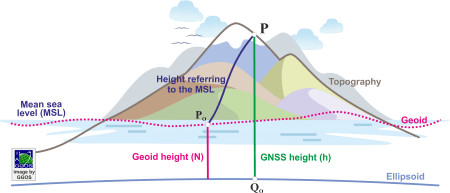International Height Reference Frame IHRF – Coordination Centre
From the GGOS Focus Area Unified Height System
to the IHRF Coordination Centre
One initial objective of the Global Geodetic Observing System (GGOS) of the International Association of Geodesy (IAG) was the standardisation of height systems worldwide. In this way, the GGOS Focus Area Unified Height System (GGOS-FA-UHS) was established in 2010 to lead and coordinate the efforts needed towards the establishment of a global standard for the precise determination of physical heights. The GGOS-FA-UHS activities rely on the contribution of several IAG components, namely, Commission 1 (Reference Frames), Commission 2 (Gravity Field), the Inter-Commission Committee on Theory (ICCT), the International Gravity Field Service (IGFS), and the International Earth’s Rotation and Reference Systems Service (IERS).
During the 2011-2015 term, various discussions focused on the best possible definition of a global unified vertical reference system, resulting in the IAG Resolution for the Definition and Realisation of an International Height Reference System (IHRS), which was adopted at the 2015 General Assembly of the International Union of Geodesy and Geophysics (IUGG) in Prague, Czech Republic.
During the period 2015-2019, activities were undertaken to investigate the best strategy for the implementation of the IHRS; i.e., the establishment of the International Height Reference Frame (IHRF). A preliminary selection of stations for the IHRF reference network was made and different calculation methods for the determination of potential values as IHRF coordinates were evaluated.
For the period 2019-2023, the objectives of the GGOS-FA-UHS focused on (i) compiling detailed standards, conventions and guidelines to support a consistent determination of the IHRF at global, regional and national levels; (ii) coordinating with regional/national experts in gravity field modelling the computation of a first IHRF solution; and (iii) designing an operational infrastructure that will ensure the long-term sustainability and reliability of the IHRF. With these objectives achieved, the GGOS-FA-UHS completed its goals and was closed during the IUGG 2023 General Assembly in Berlin, Germany.
The focus is now on the operational infrastructure required to ensure the maintenance and availability of the IHRS/IHRF in the future. In line with IAG practice, the development of theory and methods for the continuous improvement of the IHRS/IHRF will be continued by the IAG Commissions and the ICCT, while the operational performance will be ensured by the IAG Services, in this particular case the IGFS. With this in mind, the Central Bureau of the IGFS has developed a proposal for the establishment of a central coordinating body for the IHRF, composed of individual modules, which take care of the main components of the IHRF. The central management body is the IHRF Coordination Centre and its modules are the IHRF Reference Network Coordination, the IHRF Conventions’ Coordination, the IHRF Associate Analysis Centres and the IHRF Combination Coordination.
 Data flow between the IHRF Coordination Centre and its modules
Data flow between the IHRF Coordination Centre and its modules
The IHRF Coordination Centre will be responsible for the general coordination of activities required for the IHRF and for the storage, publication, and servicing of the IHRF. The IHRF Reference Network Coordination will implement and keep updated a catalogue of the IHRF global reference stations, including decommissioning of destroyed stations and the addition of new stations to replace removed stations or improve the geographical distribution. The IHRF Conventions’ Coordination is responsible for the maintenance of a catalogue containing the conventions and standards needed for the IHRF and should assess the impact that revisions in these conventions will have, providing the necessary theoretical and methodological updates that need to be introduced to the existing station coordinates. The IHRF Associate Analysis Centres are those national/regional agencies/bodies that contribute to the realisation of the IHRF by providing the potential values at the IHRF stations located in their countries/regions, following the conventions outlined by the IHRF Conventions Coordination and delivering detailed descriptions about their calculations. The IHRF Combination Coordination will be responsible for the combination and quality assessment of the regional/national solutions and for releasing the final (official) IHRF solution. The IHRF Reference Network Coordination, Conventions’ Coordination, Associate Analysis Centres and Combination Coordination should report to the IHRF Coordination Centre, which, in turn, would report directly to the IGFS Central Bureau.
The IGFS presented this proposal to the IAG Executive Committee at its meeting on December 10, 2023, and it was unanimously approved. Thus, a new component of the IGFS dedicated to the IHRF has been born and it will ensure the long-term availability and reliability of the IHRF.
More details on the IHRF Coordination Centre (IHRF-CC) based on its Terms of Reference can be found in the IGFS webpage. A dedicated web front-end for the IHRF-CC is under development.
http://igfs.topo.auth.gr/wp-content/uploads/2024/01/IHRF_CoordinationCenter_v4.pdf
Laura Sánchez, GGOS President, Technische Universität München, Deutsches Geodätisches Forschungsinstitut (DGFI-TUM), Germany
George Vergos, Director of the IGFS Central Bureau and Chair of the new IHRF Coordination Centre, Aristotle University of Thessaloniki, Department of Geodesy and Surveying, Laboratory of Gravity Field Research and Applications, Greece
Riccardo Barzaghi, Chair of the IGFS, Politecnico di Milano, Department of Civil and Environmental Engineering, Italy

 Freepic
Freepic

